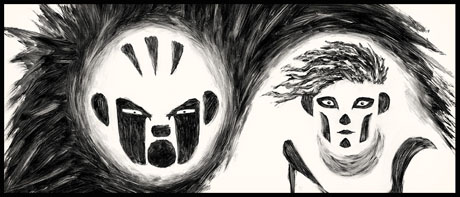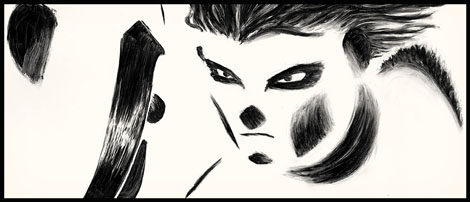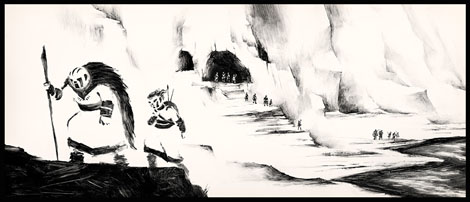
As the Oscar race heats-up, the directors of animated short film Traces are hoping for a nomination. Sophie Tavert Macian and Hugo Frassetto are thrilled their film is one of the 10 finalists in the category. They describe the making of this intense, visually intricate short in this Animation Scoop Email Q&A. This interview was edited for clarity.
Jackson Murphy: What appealed to you about telling a story set so long ago?
Sophie & Hugo: It comes from Sophie’s fascination for prehistory since her childhood… and a novel, Earth’s Children by Jean M. Auel. And in France we are lucky to have one of the most wonderful expressions of this time, painted caves like Chauvet or Lascaux, so it really feeds fascination and imagination. The idea of Traces was precisely born from one of these paintings, the Chauvet Cave’s fresco of the lions, a 36,000-year-old hunt scene between lions and bison. The way of life of these human beings is quite well known but there is still a lot of unknown about the meaning of these paintings, the beliefs, rituals or values. It’s so mysterious, it leaves room for imagination and it’s perfect for making up stories!

JM: How do you think themes and emotions surrounding relationships, hunting and painting from back then are still relevant today?
S&H: Traces is both universal and current. Human beings have built themselves around these two necessities: hunting to nourish the body and creating to nourish the spirit. Hunting and creating are indispensable to our lives, even today, even in very civilized and refined forms like domination or rebellion. Like a form of magic, the white component helps us to eat, create and survive. The black one, through excess or insufficiency, wounds, destroys and kills. With Traces, we tried to connect to the origins of our humanity.
JM: You successfully provide depth in the animation through the oil paintings. What challenges did you discover in trying to make that depth work?
S&H: The biggest challenge for our animation team was to animate the characters together. Each one of them has his own way of moving. The movements are sometimes complex, with 360 degrees. Above all, they had to maintain proportions and ensure fluidity of movement. Some sequences were really high levels of animation, for example the fight between the master and her apprentice in front of the cave: the two characters intermingle, the movements had to express tension and then violence, and the action is very fast. Technically, we created the images in two stages: character animation and scenery. By working in layers, we were able to focus first on the fluidity of the animation and then on the harmony of the composition. In order to give depth, we used the technique of atmospheric perspective used by Leonardo da Vinci or masters of asiatic ink landscapes. It consists in blurring the backgrounds in order to give the illusion that they are far from the viewer. We also chose a wide image ratio, equivalent to the cinemascope. This allowed us to play with very wide landscape shots or strong contrasts between foreground and background.
JM: How stressful was the making of Traces, knowing that you were only accomplishing about 20 images (or two seconds of animation) a day?
S&H: Very stressful! We only had six months of animation with four animators. It’s not so big for the work we had. Painting on glass leaves no room for error. When the animator engages the characters in a movement, there is no turning back. If the movement doesn’t work, you have to redo the whole movement. So every brushstroke becomes a challenge. And it’s a huge pressure on the shoulders of every animator. We had to deal with that too as directors!

JM: The “sand on a glass plate” technique you use is fascinating. Can you further explain the process?
S&H: Like oil painting, it’s a frame by frame animation and we use the same tools. The difference is that sand is a more malleable material: shapes quickly come to life. Hugo, the unique sand animator on Traces, often works with his fingers too. It is a material which makes it possible to animate in a very artisanal way: one puts the hands there and that really reconnects to the origins of art. Hugo likes to let go and get involved in a movement without knowing where it will lead him. He lets himself be carried away by the opportunities of the material. The very rough rendering we wanted with the sand also makes it easier to accept “mistakes”.
JM: How did you capture sounds of nature, animals and movements?
S&H: With Fabrice Faltraue, our amazing sound designer and music composer, we start from two ideas: nature and “stone age”. We were looking for a sound universe that evokes distant times, that appeals to our collective unconscious but that also sounds unexpected, to avoid sound clichés. We also wanted the soundtrack to have a narrative role, accompanying the supernatural dimension of the film in connection with sand. The sound of Traces is a mix between natural noises, stone noises, voices and electronic sounds.

JM: Is it true that some of the artwork of the film was shown in France at Ciclic Animation in early 2018? How was that experience… and how has it been having this short be a part of your lives for several years now?
S&H: Ciclic is a unique place, which welcomes film crews in shared apartments and provides animation studios. We spend six months together. We live and we work. We cross paths with the teams from all over the world of the other films being made. Finally making the film also becomes an experience of living together, of encounters, card games, climbing outings and soccer world cup – France-Belgique 2018 😉 Of the long process that leads to the film, Ciclic is a very special moment, a “team moment”.
Like all creation, like all birth, Traces has been a joy and a suffering. Always believing in it and working hard is sometimes tiring. And at the same time, be inhabited by the characters, the story and the universe, it feeds. It is also the birth of a baby in the flesh, Sophie’s daughter, since she gave birth during the manufacturing process. Two babies in the same [period of] time. A very bad idea but there are some things you can’t control 🙂
JM: You’re one of the 10 Best Animated Short Film Oscars finalists. What would an official nomination (and winning) mean to you?
S&H: We never imagined that we would one day be part of these ten films. We made a handcrafted film with a traditional technique and it’s as if the Oscars were untouchable for this film. So we are very grateful to the Academy and its members for giving us this incredible opportunity. Overall, we are very proud to represent, alongside these nine other films, an abundant and inventive world of animation, where all techniques and all universes cohabit, where each creation has its story, its importance and its “magic power”.
- INTERVIEW: “Inside Out 2” Director And Producer On Pixar Sequel - April 16, 2024
- INTERVIEW: “Puffin Rock And The New Friends” And 25 Years Of Cartoon Saloon - April 10, 2024
- INTERVIEW: “Chicken For Linda!” Directors On Annecy Winning Feature - April 9, 2024


 February 25th, 2021
February 25th, 2021  Jackson Murphy
Jackson Murphy  Posted in
Posted in  Tags:
Tags: 






